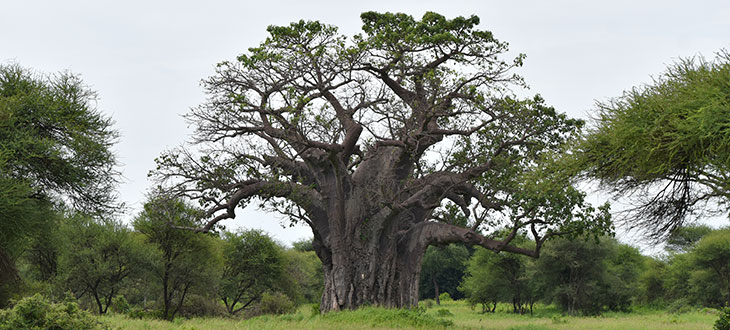10 Plants That Grow In Savannas
Do you want to know what plants grow in savannas? Here’s a list of plant species that you can find in this dry and hot environment.
Savannas are terrestrial ecosystems composed mainly of open flat grassland areas with scattered trees. These land areas are home to many species of animals and plants adapted to hot and dry conditions.
We can find savannas throughout the world, with the most extensive areas being in Africa, South America, India, Australia, Myanmar (Burma), and Madagascar, according to Britannica.
Depending on their location, savannas can be classified into several different types such as:
- Tropical and subtropical savannas
- Temperate savannas
- Flooded savannas
- Mediterranean savannas
- Montane savannas
As the climate and particularities may differ from one savanna type to another, the plants and animals will also vary.
While the vegetation of savannas is comprised mainly of grasses, there are also various small shrubs and species of trees that can thrive in those conditions.
We have listed below some of the most standard savannas plant species to help you get an idea of the type of vegetation you can find in these ecosystems.
Contents
- 1. Acacias
- 2. Thatching Grass (Hyparrhenia)
- 3. Jackalberry (Diospyros Mespiliformis)
- 4. River Bushwillow (Combretum Erythrophyllum)
- 5. Digitgrass (Digitaria Eriantha)
- 6. Sicklebush (Dichrostachys Cinerea)
- 7. African Baobab (Adansonia Digitata)
- 8. Candelabra Tree (Euphorbia Ingens)
- 9. Rhodes Grass (Chloris Gayana)
- 10. Wild Cashew Tree (Curatella Americana)
1. Acacias
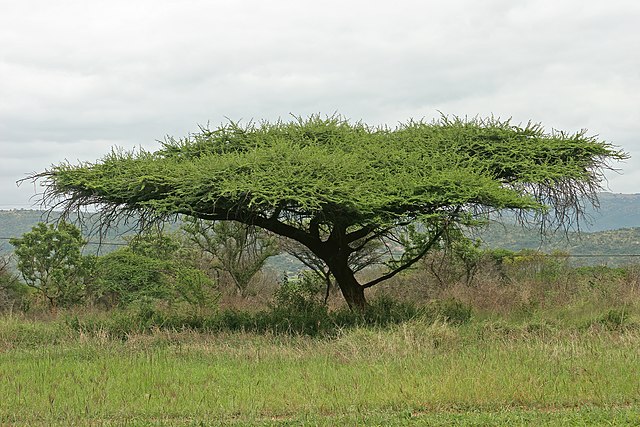
Acacia is the name of a large genus of shrubs and trees. These plants are present in all terrestrial environments, including savannas.
Two of the most common species of Acacia found in savannas are the umbrella thorn acacia (Vachellia tortilis) and Acacia senegal (Senegalia senegal).
The umbrella thorn acacia (Vachellia tortilis) is a medium to large species of tree, widespread in Africa. It is a plant that can tolerate harsh conditions, such as extreme drought, high temperatures, and rocky soils.
This tree has a pretty slow growth but can reach more than 65 ft (20 m) in height and forms a wide canopy that looks like an open umbrella. Its leaves are green, tiny, feather-like, and grow in pairs. On branches, it has both straight and hooked thorns that act as a defense system against herbivores.
Acacia senegal (Senegalia senegal) is a small tree native to the semi-desertic regions of Africa and Asia and often found in the African savanna. Some of its other common names include gum acacia, gum arabic tree, or Sudan gum arabic.
It doesn’t usually reach more than 39 feet (12 m) in height. It usually has a rounded canopy with tiny, green, bipinnate leaves. The branches, below the nodes, carry three-hooked thorns.
2. Thatching Grass (Hyparrhenia)

Hyparrhenia is a genus of over 50 species of grasses. These are commonly known as “thatching grasses” and most of them are native to tropical Africa.
Depending on the species, these grasses can be either annual or perennial, and their characteristics slightly differ from one variety to another.
The majority of these grasses grow tall and in dense tufts of slim stems that extend from a rhizome. Their leaves are green and long. The plants produce inflorescences that branch into twin spikes of paired spikelets.
Many species of Hyparrhenia are grown in pastures for grazing and covering roofs, hence their common name “thatching grasses.”
3. Jackalberry (Diospyros Mespiliformis)
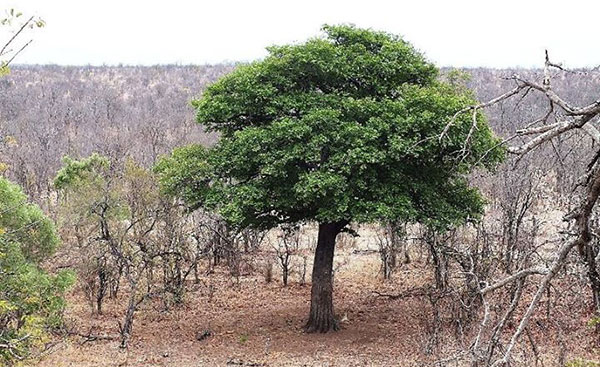
Jackalberry (Diospyros mespiliformis) is a large evergreen tree found predominantly in the African savannas. It is also commonly known as the African ebony or jakkalsbessie. It is related to the edible persimmon (D. kaki) and the true ebony (D. ebenum).
Jackalberry trees can reach up to 82 feet (25 m) in height in the optimal conditions, but most do not exceed 26 feet (8 m).
They have dense foliage with dark green elliptical leaves that have smooth margins. In the rainy season, these trees produce pale yellow, bell-shaped flowers. The female trees bear edible oval-shaped fruits, which are consumed by many species of wild animals.
4. River Bushwillow (Combretum Erythrophyllum)
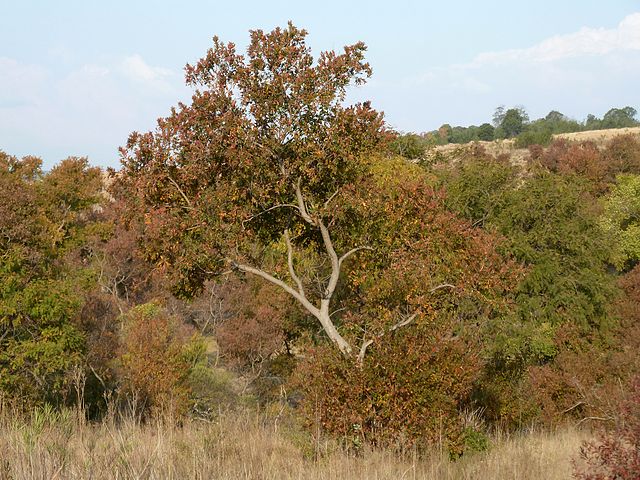
River Bushwillow (Combretum erythrophyllum) is a medium-to-large species of tree found mainly along rivers in the African savanna.
It doesn’t usually exceed 39 feet (12 m) in height. It has a fast-growing rate and is drought and frost-resistant.
River Bushwillow can be identified by its usual multi-stemmed bole (may also be single-stemmed) with a smooth pale gray or yellow-brown bark. It forms an extensive canopy, with pale green or dark green leaves of elliptical shape and smooth margins.
In spring or early summer, it produces pale yellow or cream spikes of flowers on the tips of the branches. The fruits are inedible, 4-winged, yellow to brown, and hairy at first.
5. Digitgrass (Digitaria Eriantha)
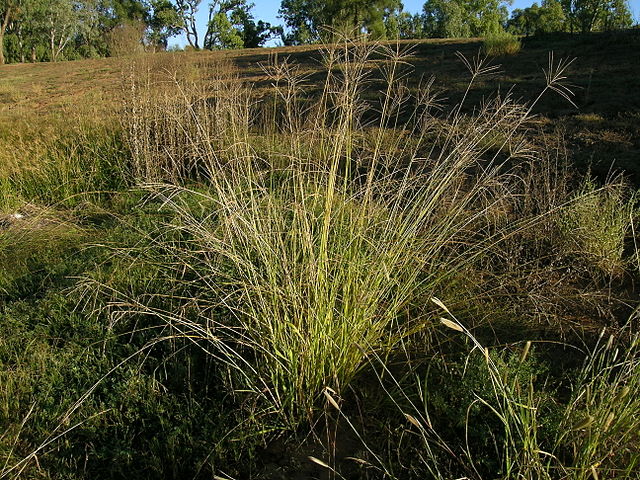
Digitgrass (Digitaria eriantha) is a species of perennial grass native to Africa but distributed in many subtropical and tropical regions throughout the world. It is also known as Pangola-grass, common finger grass, woolly finger grass, and several other names.
Digitaria eriantha is a bunch grass, forming dense clumps with extended stolons. It is a relatively tall grass and can reach more than 5 feet (1.5 m) in height.
The stems, leaves, and stolons are usually covered in fine hairs. The leaves are green, thin, and long. It produces inflorescences that generally have 6 or 7 spicate branches, each bearing multiple florets.
As it is a relatively fast-growing grass, Digitaria eriantha is frequently grown for hay and pasture.
6. Sicklebush (Dichrostachys Cinerea)
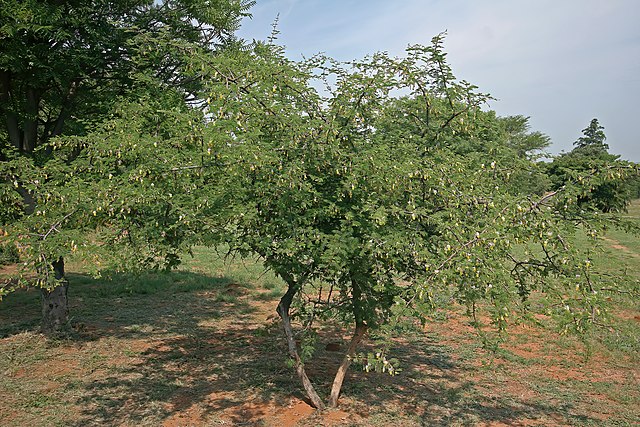
Sicklebush (Dichrostachys cinerea) is a small tree native to Africa, North Australia, and the Indian subcontinent. Other common names for this shrub include Bell mimosa, Kalahari Christmas tree, and Chinese lantern tree.
Dichrostachys cinerea is widespread throughout Africa and is often found in the savannas. It is also seen in various regions of India, Indonesia, Sri Lanka, Australia, and Madagascar.
It is a fast-growing plant and is regarded as an invasive weed in some areas because it threatens the native plant species.
Sicklebush doesn’t grow very tall and sometimes develops as a bush. Typically doesn’t exceed 23 ft (7m) in height.
Its leaves are green, bipinnately compound, and variable in size. The flowers are bicolored cylindrical spikes, pale violet in the upper part and yellow in the lower. It produces twisted pods which are consumed by animals after falling on the ground.
7. African Baobab (Adansonia Digitata)
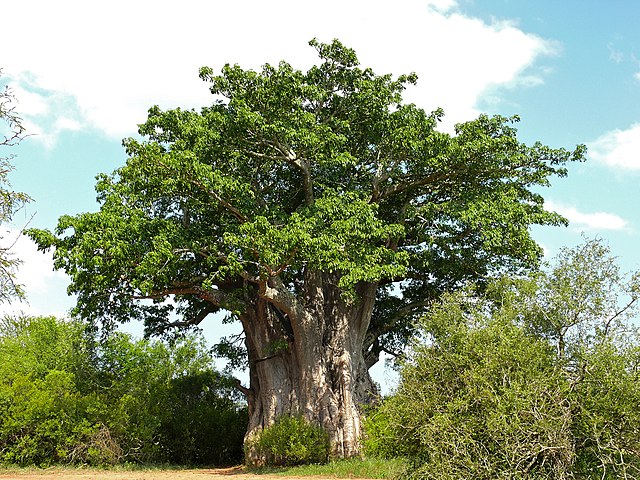
African baobab (Adansonia digitata) is a long-lived species of tree native to the African continent and Southwest Asia. These imposing trees are most commonly found in the hot and dry savannas of sub-Saharan Africa.
These trees can be easily identified by their massive, thick trunks, often bottle-shaped. They can reach more than 82 ft (25 m) in height and may live up to 3000 years. (source)
The leaves are dark green and palmately compound in mature trees. In the dry season, baobabs lose their leaves and remain leafless for roughly 8 months.
The flowers produced by these trees are large and white. The fruits are large, rounded, with a woody outer coating and a fleshy pulp inside.
8. Candelabra Tree (Euphorbia Ingens)
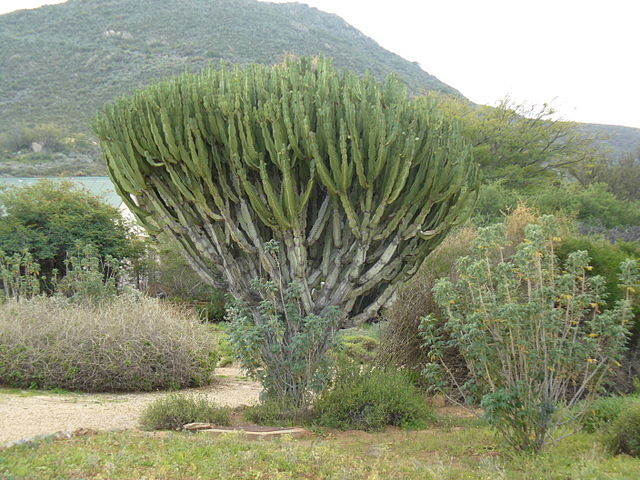
Candelabra tree (Euphorbia ingens) is a succulent tree native to dry and hot areas of southern Africa. It is generally known as the candelabra tree or naboom.
Euphorbia ingens can survive extended droughts and grow well in savannas and other dry and warm regions.
It has a slow growth but can reach more than 39 ft (12 m) in height. At maturity, its segmented branches form a rounded crown like a balloon that grows on top of a robust trunk. The succulent stems are dark green, have five ridges each, and contain a poisonous milky latex.
During the blooming period, the topmost segment of the stems produces greenish-yellow flowers.
9. Rhodes Grass (Chloris Gayana)

Rhodes grass (Chloris gayana) is a species of perennial grass native to Africa. It is a plant that can grow in various conditions and environments, including savannas.
It is a tall grass that can reach about 10 ft (3 meters) in height. It grows in tufts and spreads through stolons.
The flowering stems are upright, smooth, shiny, and usually branched. The leaves are dark green, elongated, and mostly hairless. At the tops of the stems, it produces seed-heads, each with several branches and many flower spikelets.
Rhodes grass is also grown in some regions as a palatable graze for animals and to reduce soil erosion.
10. Wild Cashew Tree (Curatella Americana)
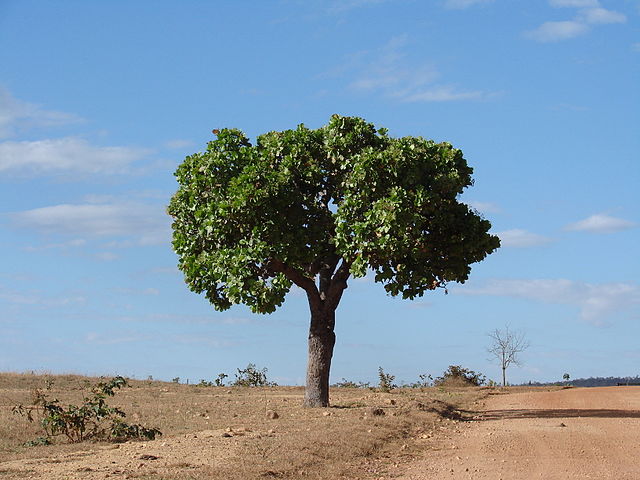
Wild cashew tree (Curatella americana), or sandpaper tree, is a semi-deciduous species of tree native to the tropical Americas. It is generally found in savannas and dry forests.
It normally doesn’t grow more than 33 ft (10 m) in height. It has a short and thick trunk and a crown that is rounded and dense.
The leaves are dark green and have a hard, rough surface, hence its common name “sandbox tree.” It produces hairy edible fruits and seeds.
Wild cashew tree is frequently grown as an ornamental plant.
Final Word
Savannah vegetation consists predominantly of grasses. However, as mentioned earlier in this article, there are also certain species of trees, shrubs, and other plants with adaptations to survive the conditions of these hot and dry environments.
We hope that the plants listed in this article will give you a better idea of the plant species that grow in savannas.

